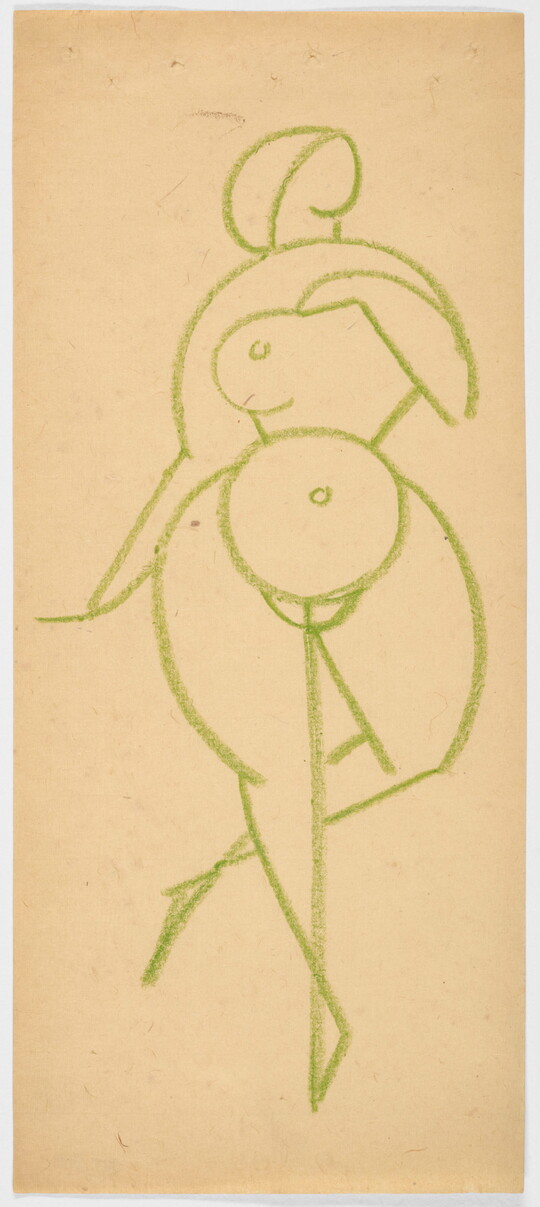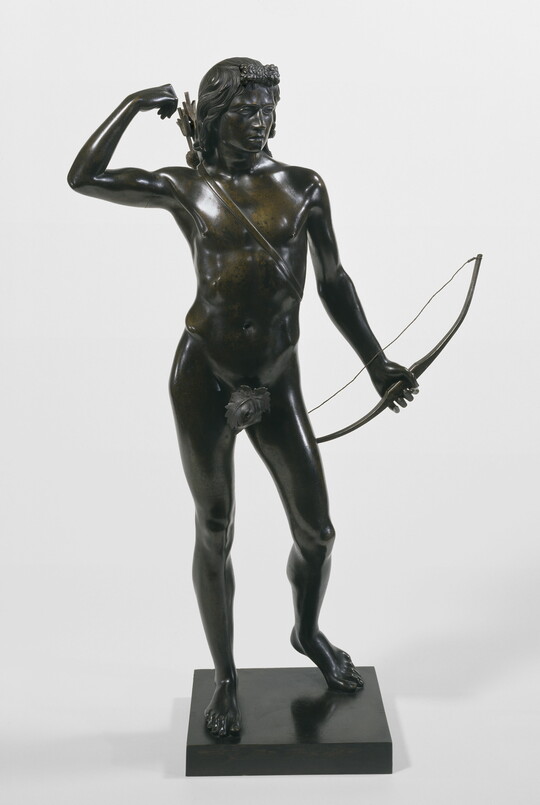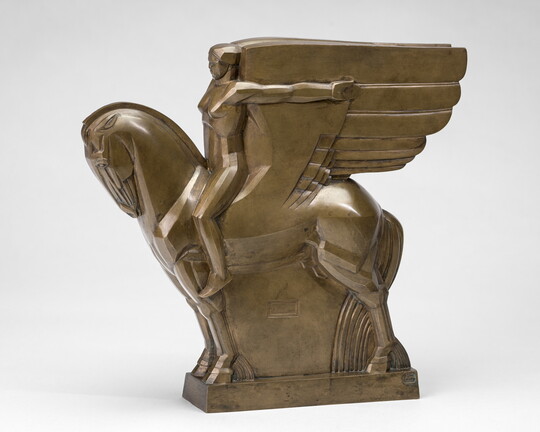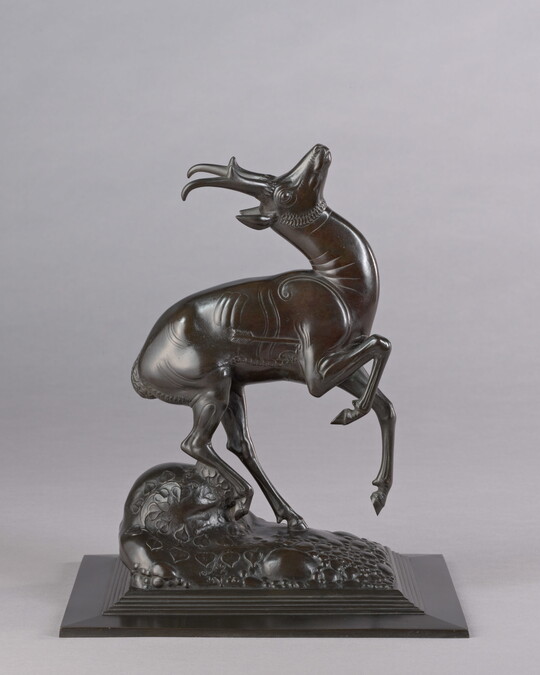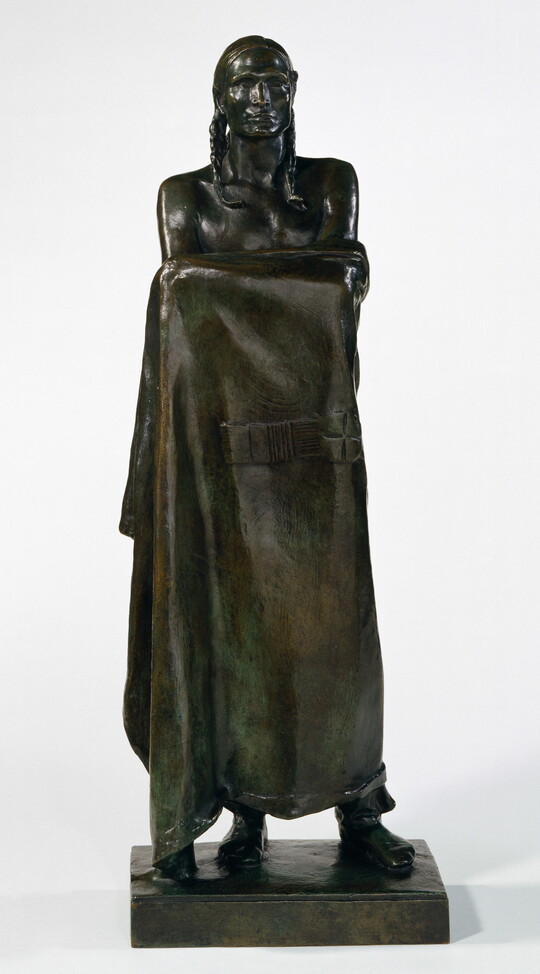








Artwork Images
Photo:
Controls
Woman Seated
Object Details
-
Date
1918, cast 1925
-
Object Type
Sculptures
-
Medium
Bronze with nickel plate
-
Contributors
Cast by Roman Bronze Works
-
Dimensions
12 5/8 x 10 5/8 x 9 1/2 in.
-
Edition
1 of 4 recorded lifetime casts
-
Inscriptions
On base:
signed and dated: G. LACHAISE \ 1925
inscribed: ROMAN BRONZE WORKS N-Y-
-
Credit Line
Amon Carter Museum of American Art, Fort Worth, Texas, Purchase with funds provided by the Council
-
Accession Number
2007.8
-
Copyright
Public domain
Object Description
When he was just 16 years old, Lachaise qualified to study sculpture at the acclaimed École des Beaux-Arts in Paris, where his future career as an artist was assured. Upon meeting Isabel Dutaud Nagle, a married Canadian-American woman 10 years his senior, Lachaise fell in love and followed her to the United States. After waiting over 10 years for her divorce, Lachaise married Isabel, and she became the artist’s sole muse and model for his vision of universal womanhood. Seated in a chair, wearing an evening gown, slippers, and a hair comb, she appears here as the essence of a modern woman. Confident and stately, Nagle’s figure evokes associations with goddesses and earth mothers.
—Text taken from the Carter Handbook (2023)
-
We the People: Picturing American IdentityJune 15–September 8, 2013
This exhibition focuses on the fluidity of national identity through the creations of American artists, particularly in key moments in history when the definition of a singular American identity was challenged and ultimately reshaped.
-
A New American Sculpture, 1914-1945: Lachaise, Laurent, Nadelman, and ZorachFebruary 17–May 13, 2018
A New American Sculpture investigates the integral relationships between modernism, classicism, and popular imagery in the sculpture of these four immigrant artists, showing how they redefined sculpture’s expressive potential during this rapidly changing time.
-
From Remington to O’Keeffe: The Carter’s Greatest HitsOctober 6, 2018–March 22, 2019
During the renovation, this exhibition features highlights from the permanent collection, including paintings, photographs, and sculptures, by some of America’s most renowned artists.
Additional details
Location: Off view
See more by Gaston Lachaise
Tags
-
On this square pedestal sits a tabletop sculpture created by immigrant artist Gaston Lachaise. Meant to be viewed from all angles, this artwork depicts a voluptuous woman, the artist’s wife and muse, formally dressed and seated in a chair.
The woman wears her hair pulled back in a tight, clean bun at the back of her head, and it covers most of her ears. A smooth, curved, rectangular hair comb sticks up from the top of her bun. Her hair and comb are nickel plated and have a brighter shine than the patina (or color of the surface) of her face. Her face is a darker patina, created in bronze. Her face rests in a neutral position. Her eyes do not have much articulation, just smooth, convex bulges. Her nose is short and pointy, and beneath that is her closed mouth. Her chin is tiny and comes to a point that sticks out from the bottom of her face.
Her décolleté, shoulders, top part of her breasts, and arms are a darker patina created in bronze. She crosses her arms right below her breasts. Her hands are tucked under her arms, leaving both her hands not visible. Across her chest and under her armpits she wears a strapless dress that is tight to her thick torso. The dress is plated nickel, which gives it a shinier, more gold-like coloring. The dress drapes closely to one of her legs that is crossed over her other leg. Her dress fans out from under her bottom and drapes over the chair, coming out at pointed edges on the seat of the chair with the hem almost touching the floor. The fabric of the dress has folds around the bed of her knee and where the long, flowy part of her dress falls and overlaps over the side of the chair. Her crossed leg kicks out toward the viewer. The skin of her foot is the darker patina seen on her face and chest, but her shoes, which are fancy, pointy slippers with a low heel, are cast in shinier polished nickel like her dress and hair piece. Her other foot is firmly placed on the ground.
The woman sits in a plain, smooth-backed chair. The back of the chair stops right at her shoulder blades. The chair’s legs are not individually articulated, but instead are a block of bronze. Her dress almost blends into the base of the chair. The base of the chair molds into the bronze square that the whole sculpture is centered and mounted on, giving the artwork a very solid base.
-
Why might the human figure take such an important place in art history? How has the human figure been portrayed differently throughout history?
Why might an artist choose the medium of sculpture to explore a subject?
How have representations of women changed over time?
-
Describe the person you see in the sculpture. What is she wearing? What do you notice about her dress and her shoes? How is her hair styled? Is she young or old? How can you tell? What is the expression on her face? Does her pose seem passive and relaxed or more assertive and commanding?
Do you think this is a portrait of a specific woman or a more generalized type of woman? Why do you think that?
Besides the figure, what else did the artist include? What is the woman sitting on? How would you describe the chair? How would you describe the floor or ground? Where do you think she might be? If you were to create a background for this sculpture, what details would you include?
Thinking about all the details discussed above, if she were a character in a story, what do you think this woman might do or say next?
What materials did the artist use to create this sculpture? What do you notice about the colors and textures of the artwork? What else do you notice about the surface of the sculpture? Why do you think the artist chose to create a metal sculpture of the subject instead of using another medium like painting?
-
Grades 1–5
Students will draw or paint a background for this sculpture. Students should consider these questions: Is she inside or outside? Are there other people nearby? Is she in a private space like her home or in a public space like an event?
Grades 4–8
Students will write a fictional biography of the figure in the sculpture. Who is she? Where is she from? Where does she currently reside? Who are her friends and family? What was her childhood like? What is her occupation? What activities or pursuits does she enjoy? What are her dislikes? How would one describe her personality?
Grades 4–12
Students will create a sketch of the sculpture. Students should consider these questions: What do they notice about the lines, shapes, and texture? Where does the light reflect the most, and where do the shadows fall?
All Levels
Using clay or other available materials, create a sculpture of a seated figure. What is the figure wearing? How is it posed? What is the figure’s expression? What kind of chair is the figure sitting on?
Share Educator Resources
Amon Carter Disclaimer
This information is published from the Carter's collection database. Updates and additions based on research and imaging activities are ongoing. The images, titles, and inscriptions are products of their time and are presented here as documentation, not as a reflection of the Carter’s values. If you have corrections or additional information about this object please email us to help us improve our records.
Every effort has been made to accurately determine the rights status of works and their images. Please email us if you have further information on the rights status of a work contrary or in addition to the information in our records.
Related Works
-
Coming Through the Rye, 1902
Frederic Remington
Bronze
1961.23
-
Green Nude, ca. 1920
Gaston Lachaise
Crayon on paper
2018.4
-
The Choosing of the Arrow, 1848
Henry Kirke Brown
Bronze
1997.143
-
The Freedman, 1863
John Quincy Adams Ward
Bronze
2000.15
-
Untitled, 1970
Luchita Hurtado
Lithograph
1970.86
-
Study for a Monument to Walt Whitman, 1919-1920
John Bradley Storrs
Bronze
2001.1
-
Pronghorn Antelope, 1914
Paul Manship
Bronze
1997.3.B
-
An American Stoic, 1912
Alexander Stirling Calder
Bronze
2002.4
-
Benediction, 1922
Daniel Chester French
Bronze
2005.17









